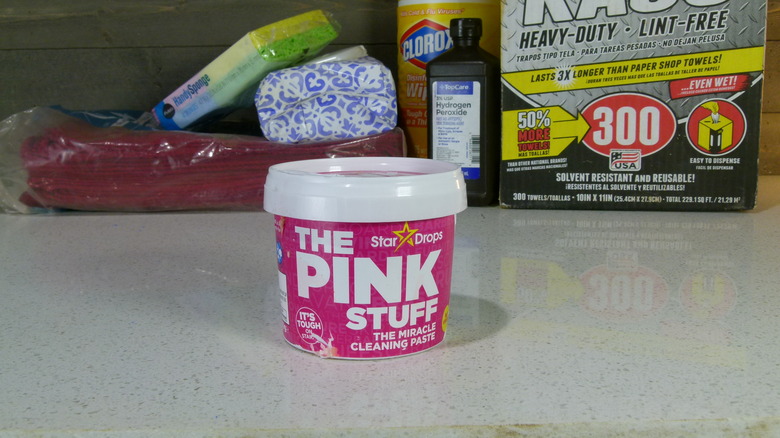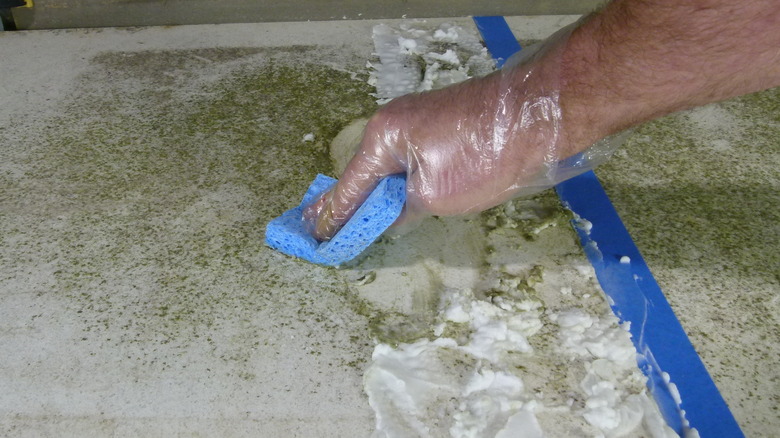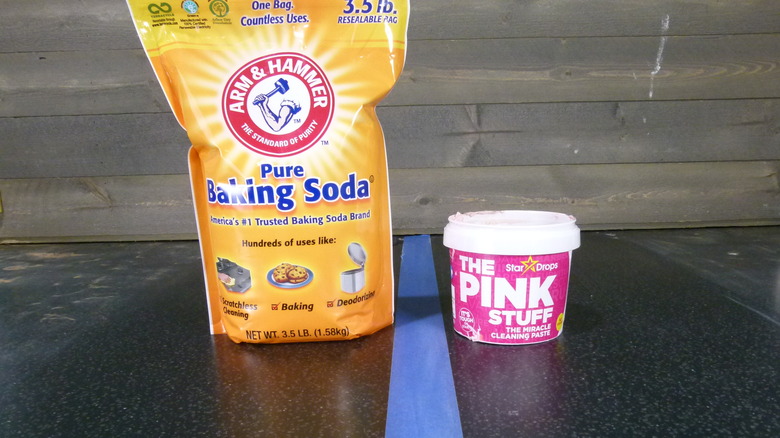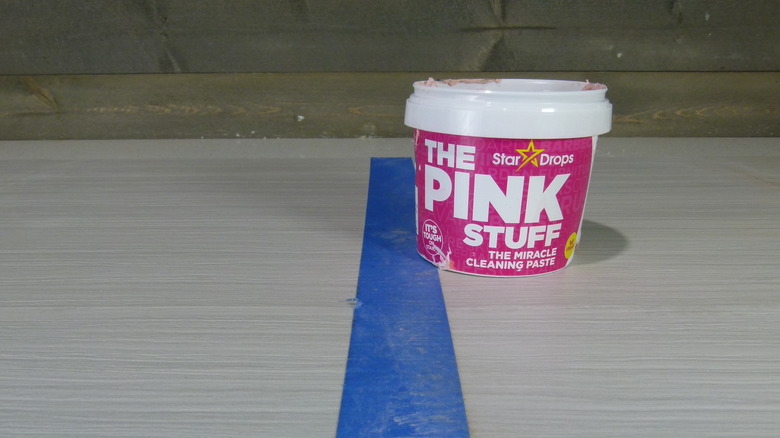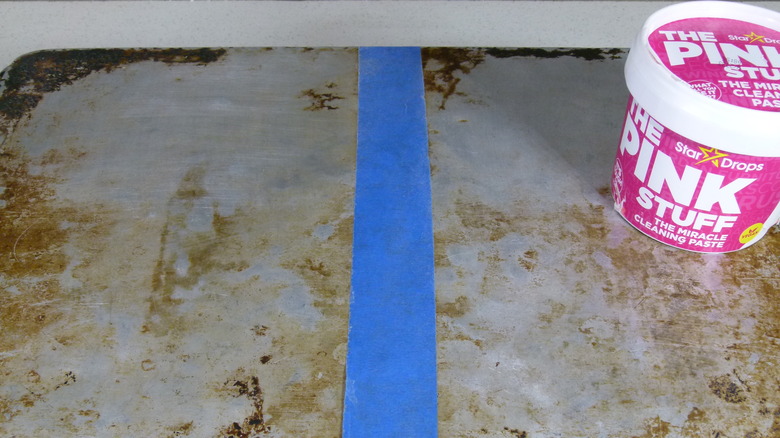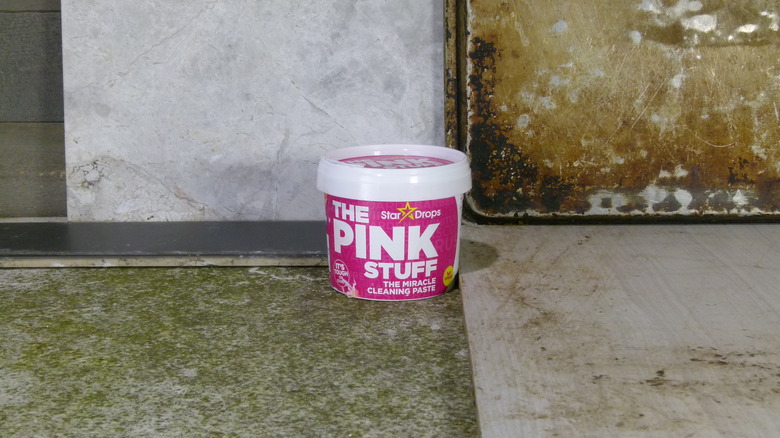The Pink Stuff: TikTok's Favorite Cleaner Barely Edges Out The Competition
TikTok isn't where most people would seek cleaning advice, but then TikTok isn't really the place for seeking anything. So when we hopped down a rabbit hole after a glimpse of The Pink Stuff, we weren't sure what to expect. We only knew that some people seem to really believe in this inexpensive and unassuming (but for its color) cleaner. The #thepinkstuff hashtag sports 616.3 million views. We couldn't find any way to sort the videos by most-viewed or most-liked, so we let the algorithm do the work for us and had a look at what they bloody well told us to have a look at. We watched serious people, ordinary people, and a handful of people wearing fewer clothes than one might expect cleaning toilets, pots, pans, tile, sinks, countertops, ovens, stovetops, sheet pans, and more.
Of course, the job of a creator on TikTok is to convince you to watch a video, not to get your kitchen clean, so one takes the hype with a grain of salt, realizing that expectations borrowed from influencers, organization experts, and people with unbelievably soiled kitchen sinks must be tempered with sense. For example, one TikTokker apparently used The Pink Stuff to clean her "depression apartment," which seems an expectation beyond the abilities of any $6 paste.
We ordered a $5.97 tub of the stuff (10.58 ounces, if you are the precise sort) from Amazon and got busy waiting. And, you know, watching TikTok videos.
Basics of The Pink Stuff
The Pink Stuff, it turns out, is a variety of pink stuffs. The name graces a dozen cleaners in different states of matter, from solid to liquid to bathroom foam. We ordered the original "miracle cleaning paste." The ingredients list (from the UK Detergent Product Information site) includes quartz, water, soap, sodium carbonate, sodium silicate, sodium bicarbonate, glycerin, perfume, laurylamine dipropylenediamine, red 52, and dimethicone. Chemistry Cachet got a material safety data sheet (MSDS) from Star Brands, and "soap" appears to include sodium palmate, sodium palm kernelate, and sodium cocoate. Quartz is used as a fairly aggressive abrasive, and everything else is fairly mild fare for a household cleaner. Star Drops, the maker of The Pink Stuff, is perfectly clear: This stuff is a "mild abrasive," and you should be careful, particularly with "glass, highly polished steel surfaces, and ceramic hobs" (glass-topped cooking surfaces).
Part of the pitch for The Pink Stuff is that the ingredients are natural and vegan. However, Laurylamine dipropylenediamine probably can't be described as a "natural ingredient," and its own MSDS is mildly terrifying. Still, it's common in personal care products and the expert consensus says it's safe.
One note: opening our package, we expected to see the familiar pink tub, but ours was shrink-wrapped in black and the tub itself, somewhat flimsy, was broken and spilling its contents onto everything else in the box. Fortunately, it turns out that Pink Stuff is good at cleaning itself and came cleanly off everything.
Our countertop test
From the enormous range of claims among TikTok users, we chose three to check out, partly based on how common they were and partly on whether we could put our hands on a surface sufficiently filthy to warrant test-cleaning. The latter turned out to be depressingly easy. We also cleaned an area of each item with a mixture of baking soda and hydrogen peroxide, a homemade, nontoxic cleaner with a solid reputation for handling tough jobs.
Expecting the sheet pan test to be unreasonably tough, we started with the countertop cleaning test, which promised to be pretty straightforward. We found a slab of composite countertop from an office and an offcut of quartz, both of which had been stored outdoors for a few years. They were dirty, to be sure, but probably not as dirty as you'd find in a kitchen that hasn't gotten much attention in a while. The composite was simply soiled, while the quartz appeared to have a green mold-like film covering its unpolished side.
The Pink Stuff seemed to work great on both. The composite's finish seemed dull after cleaning, but we got the same result with the baking soda/hydrogen peroxide paste. In fact, the two cleaners' results were so nearly identical that we tested an additional area by just cleaning with water, and with the same amount of effort, the water did as well as the other two.
The tile test
Cleaning grout, particularly unsealed grout, threatens to be impossible in any given situation. Mold, dirt, and pigments of all sorts (none of which are ever the color of the grout) are drawn to grout like magnets to, well, magnets. Fortunately for us, we couldn't find a sufficiently filthy sample of grout to test, but we found some tile that was recovered from a flood. We chose three samples to test: a smooth, black ceramic; a light, textured ceramic; and a natural marble. A lot of the dirt and stains appeared to be simple surface crud we expected to clean up nicely.
The marble was the least soiled of the tiles, and again both The Pink Stuff and the baking soda/peroxide combo did a perfectly good job of cleaning it. We did notice that both cleaners left the marble darker than it was in the uncleaned area, but this was probably due to the habit unsealed marble has of temporarily absorbing a little water and darkening. We cleaned both using the circular motions common on TikTok and straight strokes along the textured ridges of the large format tile, but again both cleaners did a great job and we couldn't tell any difference in the results.
Finally, the black ceramic tile was a quick job. It appeared that The Pink Stuff got the tile slightly cleaner than the baking soda/hydrogen peroxide paste, but if so, the difference was minuscule.
The sheet pan test
One of the more common uses of The Pink Stuff on TikTok is cleaning the bottoms of cooking pots. We found some half-sheet pans at a restaurant liquidation sale that were similarly soiled. No grime is more stubborn than baked-on grease from a home cooking-style restaurant, and no cleaner (at least, any we were willing to share a room with) was going to remove all of the stuff from the bottoms of these sheet pans. Ideally, this would allow us to finally see a marked difference between the performance of The Pink Stuff and the baking soda/peroxide mixture.
After letting the pastes soak into the surface for 30 minutes, we put an equal (and not inconsiderable) amount of elbow grease into each side of the sheet pan. After the initial cleaning, it appeared that The Pink Stuff did a slightly better job removing the crud, but neither could be said to have done a great job at this impossible task. Our theory was that the abrasives in The Pink Stuff assisted its performance, so we divided each side in half again and continued cleaning a quarter with steel wool and The Pink Stuff and a quarter with steel wool and baking soda/peroxide. We thought that the more aggressive steel wool abrasive would negate any advantage afforded by the quartz in The Pink Stuff, but again (and perhaps even more clearly), The Pink Stuff outdid the baking soda mixture.
The Pink Verdict
After watching the TikTok videos, one could be forgiven for concluding that so many people are enamored of The Pink Stuff because they haven't spent much time cleaning in the past and therefore can't judge the product's effectiveness versus the competition. And perhaps some can't tell how much effort is ordinary for certain cleaning tasks. Watching someone scrub the grime, and possibly the electrons, out of grout with marginal results is painful and rightly makes one question one's determination to avoid harsh chemicals.
While we only saw a clear difference between The Pink Stuff and baking soda/hydrogen peroxide on our sixth test, it's important to keep in mind that baking soda/peroxide is a well-regarded DIY cleaning mixture — and to say that a commercial product compares favorably to it is no small thing. Our impression was that The Pink Stuff is a capable general-purpose cleaning paste for any surface not prone to being scratched by abrasive cleaners. Still, we couldn't describe its performance as spectacular in a way that would explain its TikTok fame.
If miracle products existed, they wouldn't have competition. The closest things we have to miracles all have their limitations. Magic Erasers, for example, are best avoided for nonstick cookware and high-gloss or clear-coated paint finishes. Thankfully, you don't have to require the impossible from a product to like it — such unreasonable expectations doom products (as well as marriages and political systems) all the time.
